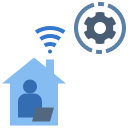Leveraging Technology for Optimal Remote Work Performance
Harnessing the right technological tools is critical to achieving high productivity and satisfaction in remote work environments. As more organizations adopt hybrid and fully remote frameworks, leveraging digital solutions is no longer optional but essential. This page delves into how technology can streamline processes, enhance communication, safeguard sensitive data, and support seamless team collaboration, ultimately driving optimal remote work performance.
Cloud-Based File Management Tools
Cloud-based file management platforms are the centerpiece of remote work infrastructure. They allow teams to store, share, and collaboratively edit documents in real time, regardless of location or timezone. Reliable cloud solutions provide version control and granular access permissions, ensuring data integrity and security. With centralized document repositories, employees spend less time searching for files and more time focused on value-adding tasks. Moreover, automatic backup and synchronization features reduce the risk of data loss, offering peace of mind for both staff and management.
Hardware Essentials for Remote Efficiency
Beyond software, the hardware set-up significantly impacts the remote work experience. High-quality webcams, noise-cancelling headsets, and ergonomic accessories contribute to productivity and comfort. A reliable computer equipped with up-to-date operating systems and security protocols enhances performance by reducing technical hiccups that might otherwise slow down important work. Fast and stable internet connections are equally vital, supporting smooth video calls and uninterrupted access to cloud platforms. Investing in essential hardware upgrades can drastically improve daily workflows and reduce frustration for remote workers.
Secure Connectivity Solutions
Secure connectivity is imperative in remote work to protect sensitive company information and maintain compliance with data regulations. Virtual Private Networks (VPNs) and multi-factor authentication methods help shield confidential communications from external threats. Encryption protocols further fortify data exchanges, ensuring that business-critical information remains private. Remote teams benefit from establishing clear guidelines and user training around secure network practices, which together form a resilient first line of defense against cyber risks and empower employees to work confidently from any location.
Enhancing Communication and Collaboration
Videoconferencing Platforms
Videoconferencing tools have revolutionized remote teamwork by enabling face-to-face interaction from anywhere in the world. Reliable platforms offer features like screen sharing, breakout rooms, and meeting recordings, making virtual meetings as dynamic as those held in-person. They facilitate more personal connections, reduce misunderstandings, and provide an easy medium for both formal briefings and informal social gatherings. Encouraging regular video check-ins helps foster trust and keeps remote employees emotionally engaged with the company culture.
Asynchronous Communication Channels
Asynchronous communication tools, such as chat applications and project management systems, empower teams to stay connected even when they are not working in the same timezone or at the same time. These platforms support threaded discussions, file attachments, and progress tracking, making it easy to document conversations and revisit decisions. By reducing the pressure for immediate responses, asynchronous solutions can alleviate stress and give team members the flexibility they need to balance work with personal responsibilities—an essential ingredient for sustainable productivity.
Real-Time Collaborative Workspaces
The advent of real-time collaborative workspaces has drastically improved the ability of remote teams to ideate, problem-solve, and co-create without geographic constraints. Features such as live document editing, interactive whiteboards, and shared task lists eliminate versioning confusion and streamline group efforts. These digital environments encourage transparency and accountability by providing clear visibility into project statuses and individual contributions. As a result, teams achieve better alignment, faster turnaround times, and increased motivation across all participants.


Workflow automation software allows remote teams to design and implement digital processes that execute defined actions based on triggers and conditions. This removes the need for manual interventions in routine tasks such as approvals, notifications, and data entry. By ensuring workflow steps are followed accurately and automatically, organizations can preserve quality, reduce oversight costs, and accelerate project completion. Additionally, the transparency offered by these platforms makes progress measurable and bottlenecks easier to identify and resolve.

Time management is particularly challenging when working remotely, with competing demands and fewer natural cues separating work from leisure. Scheduling and calendar applications equipped with smart automation features provide personalized reminders, prioritize tasks, and synchronize meetings across time zones. These tools help remote workers maintain structure and manage their daily routines efficiently. Automated scheduling assistants can also minimize scheduling conflicts, freeing up brainpower for creative and critical thinking rather than administrative chores.
Access to accurate and timely data is crucial for decision making in a remote work setting. Automated reporting and analytics solutions collect, organize, and visualize performance metrics with minimal manual input. This enables managers and team members to monitor progress in real time and identify opportunities for continuous improvement. Proactive alert systems notify stakeholders of trends or anomalies before they escalate into problems, supporting a data-driven approach to remote productivity and strategic planning.
